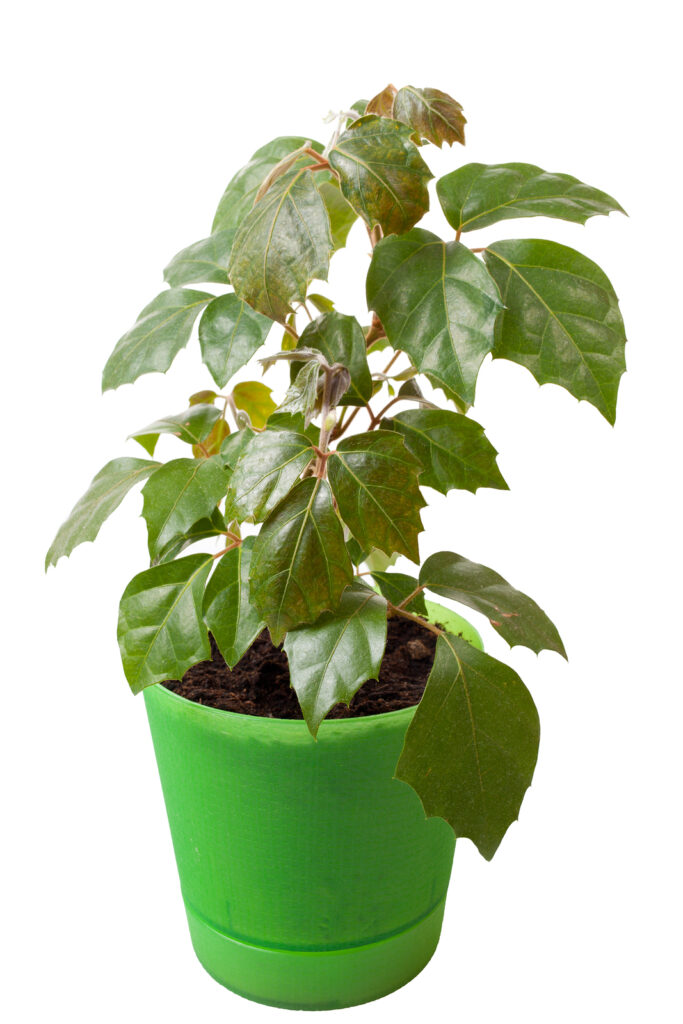Cissus–commonly called Grape ivy–is an evergreen tropical vine with dark green foliage. Leaves are divided into diamond-shaped leaflets. Grape ivy is a favorite houseplant. In semi-tropical regions is can be trained on a trellis or pergola.
Cissus are tendril-climbing shrubs from tropical regions. They are mostly grown indoors in temperate regions but can be grown outdoors in tropical and subtropical regions.
Cissus is a genus of about 350 species of evergreen perennials, shrubs, and climbers. Cissus is native to forest margins and thickets in tropical regions worldwide.
Get to know Cissus
- Plant type: Evergreen perennial tropical vine
- Growing Zones and range: 10-11
- Hardiness: Houseplant in most regions; used as a vine or groundcover in warm regions
- Optimal growint temperature: day 68° to 75°F (20°-24°C), night 60° to 65°F (16°-18°C)
- Height and width: Grape ivy grows to 10 feet (3m) long
- Foliage: Tendril-climbing vines to 10 feet long, sometimes leaves are fuzzy underneath.
- Flowers: Insignificant 4-petlaed flowers
- Uses: Houseplant, hanging baskets; in tropical regions grow on a trellis or pergola
- Common name: Grape Ivy
- Botanical name: Cissus spp.
- Family: Vitaceae
- Origin: Tropicla and subtropical regions around the world
Where to plant Cissus
- Grow Cissus in medium to high light; keep grape ivy out of the direct sun.
- Pot Cissus in an all-purpose mix that is well-drained.
- Outdoors grow Cissus humus-rich, well-drained soil.

When to plant Cissus
- Set Cissus outdoors any time of the year in tropical regions.
How to water and feed Cissus
- Soak plants just as the soil dries. Allow soil to dry out between soaking. Cissus needs medium humidity.
- Fertilize Cissus twice a month in spring and summer, use 10-10-10 fertilizer.
- Pinch off side shoots frequently to encourage dense growth.
Cissus care
- Repot Cissus as needed.
Growing Cissus as a houseplant
- Most Cissus grow best in bright light, but they can adapt to limited light.
- Average room temperature and humidity are best.
- Cissus should be fertilized once in spring and once in summer.
Cissus pests and diseases
- Cissus is vulnerable to attack by mealybugs and spider mites.
- Cissus is susceptible to salt buildup.
Cissus propagation
- Take stem cuttings at any time or grow new plants from seed.
Cissus varieties to grow
- Cissus antarctica, kangaroo vine has shiny, leathery leaves.
- C. discolor, begonia treebine. Velvety leaves similar to Rex begonia.
- C. incisa, marine ivy. Heavily toothed, fleshy leaves.
- C. quadrangula. Climbing succulent with shiny green leaves.
- C. rhombifolia, grape ivy. Oval, leathery, bright green leaveshas large.
- C. striata, dwarf grape ivy. Compact grower with small five-lobed leaves.















